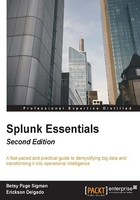
Conventions
In this book, you will find a number of text styles that distinguish between different kinds of information. Here are some examples of these styles and an explanation of their meaning.
Code words in text, database table names, folder names, filenames, file extensions, pathnames, dummy URLs, user input, and Twitter handles are shown as follows: "It is essentially a collection of databases that is, by default, located at $SPLUNK_HOME/var/lib/splunk."
A block of code is set as follows:
[wineventlogs] coldPath = $SPLUNK_DB\wineventlogs\colddb homePath = $SPLUNK_DB\wineventlogs\db maxTotalDataSizeMB = 100 thawedPath = $SPLUNK_DB\wineventlogs\thaweddb
Any command-line input or output is written as in two ways in this book. Be careful when copying commands with quotation marks. It is best to type in the entire search command to avoid problems.
If it is a Windows command, the command will be written as follows:
C:\> notepad c:\splunk\etc\apps\destinations\local\indexes.conf
If it is a Splunk command, the command will be written as follows:
SPL> index=main /booking/confirmation earliest=-24h@h | timechart count span=15m
New terms and important words are shown in bold. Words that you see on the screen, for example, in menus or dialog boxes, appear in the text like this: "Underneath Selected Fields, you will see Interesting Fields."
Note
Warnings or important notes appear in a box like this.
Tip
Tips and tricks appear like this.